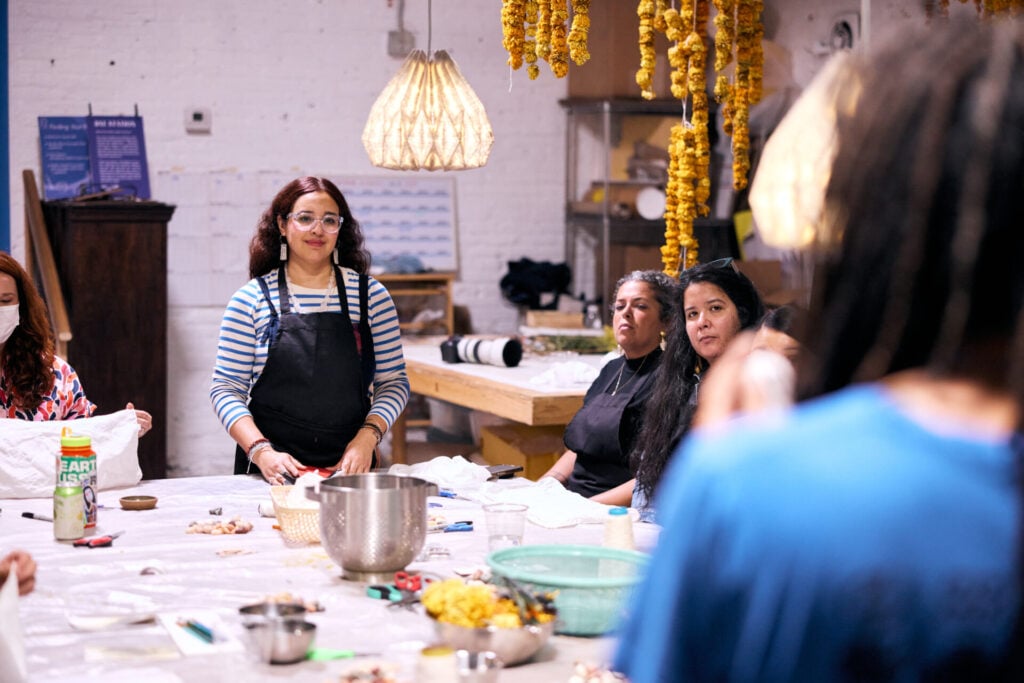For this Sunday Visit, we take a bit of a different approach. For Women’s month, I sat down with two inspiring women of our community, Janette Terrazas of Ni En More & Kenya Miles of Blue Light Junction on zoom. Janette did the Ibura Residency at Blue Light. I first met Janette 8 years ago, when I was asked to come down to Ciudad Juarez to work with the women. Ni En More is a non-profit organization dedicated to building social impact and empowerment through ethically crafted, naturally dyed clothing. I first went to Ni En More in 2016, when Trump was first elected president, when there was so much turmoil at the border. I crossed on foot from El Paso to Ciudad Juarez and was forever changed by the experiment. Now, more than ever, their stories seem more pertinent to tell.
Kenya Miles is the founder of Blue Light Junction, an artist, urban farmer and incredible host and polymath. Their mission is to center global traditions and knowledge bearers of craft and natural dye through growing and processing dye plants in community, education based workshops and events, knowledge transfer through apprenticeships and classes, and to showcase sustained research and experimentation through the Ibura Art and Research Residency, The Alternative Color Lab and The Concept Store at Studio Blue.

The transcript of the interview is below the recording. The interview tells of the community we create across borders, how our ancestry informs our practice and how hyper local community and plants can heal. The transcript is edited for conciseness and grammar.
The Audio File
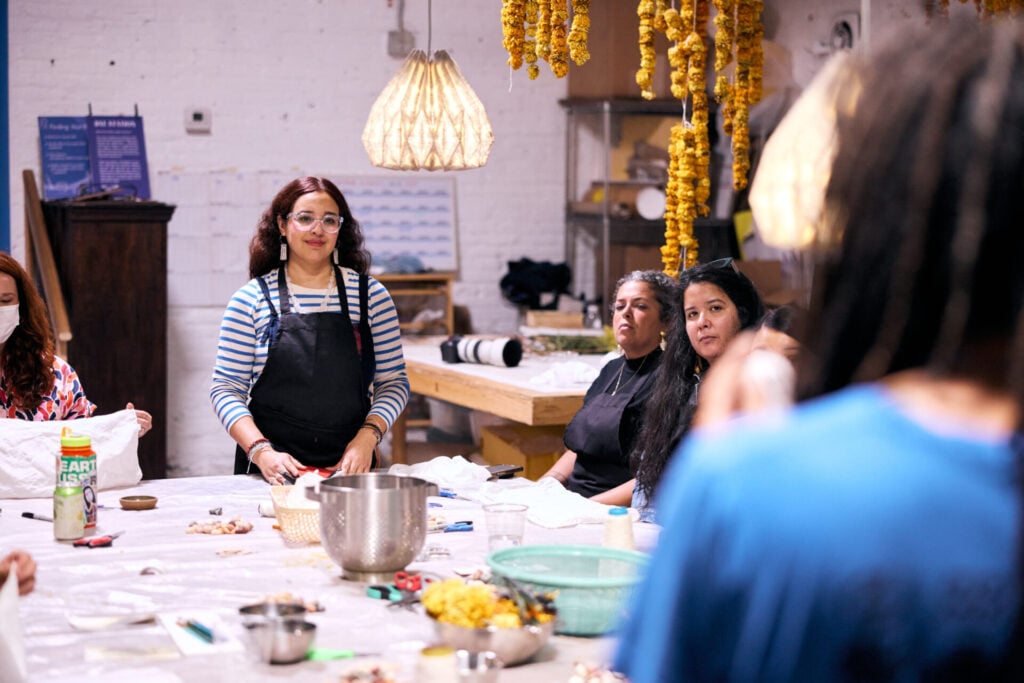
Cara: I’d love to hear about your time at Blue Light Junction – the whole story of how it came to be, and what you both got out of it. Whoever wants to start.
Kenya: I’ll start with the backstory. It was a happy accident. We run our Ibura art and research residency program every two years. In spring ‘24, we had someone new organizing, and I was trying to step back. We have jurors and a pre-screening process, but no one noticed Jeanette lived in Mexico.
Previously, I reviewed every application, which became overwhelming. This time, I looked at the jurors’ recommendations and negotiated with the Blue Light team. Jeanette was on top of all five jurors’ lists. Everyone thought she was great, but I realized we hadn’t specified that we don’t offer housing.
So I looked up your work and thought, “This person’s dope.” It felt like a kindred energy. We’re mainly Mellon Foundation-funded, and I had underspent in ‘23. I wanted to use that money to host people, and thought Jeanette could be a visiting artist, creating a hybrid residency.
When she came, it was a condensed but rich experience. We talked multiple times to sort out logistics and funding. A friend in Baltimore generously offered her accommodation. It was great how it all came together.
Cara: It was completely kismet. It’s how I met Janette, too. A Norwegian friend of Lise’s (Ni En More co-founder) flew from Norway to take my workshop in Brooklyn, just to invite me to Mexico!
I was like, “You could have just called!” But you don’t say no at that point. She told me about the women and how she embroidered their names, and we were sobbing at dinner. I was on a plane three months later. Sometimes you just get a call and say, “Okay, yeah,” and then it unfolds. Janette, tell us about your project at Blue Light Junction, and how it ties to your work with Ni En More.
Janette: A friend who’s into natural dyes sent me the Blue Light Junction link. I was excited about their garden, especially the Paso Chile and Indigo. I was developing an exhibition about my family history, focusing on purple corn pigment and using mezcal for small test pieces.
I applied, but realized it was more focused for locals. Still, I was excited when I got accepted. Kenya and I started conversations and connected over our communities’ struggles. Baltimore felt similar to Juarez – different contexts, but similar people and streets.
Connecting with the Blue Light Junction community was amazing. Baltimore felt similar to Juarez. These cultural spaces bring healing and opportunities for locals. It resonates with our work in Juarez, where we organize and build for the people. Seeing the garden, the indigo cultivation, and visiting the farm alliance was really awesome.
Meeting at Oko Farms was stunning, seeing the aquaponics and community organization. This is a significant connection, because we’re also Mellon-funded. And we’re presenting new proposals next year. I hope they keep supporting us. We’re planning to make scholarships, an open call for students of fashion design. We want to invite a mentor per group that leads the group of our fellows. Immediately I think about you both.
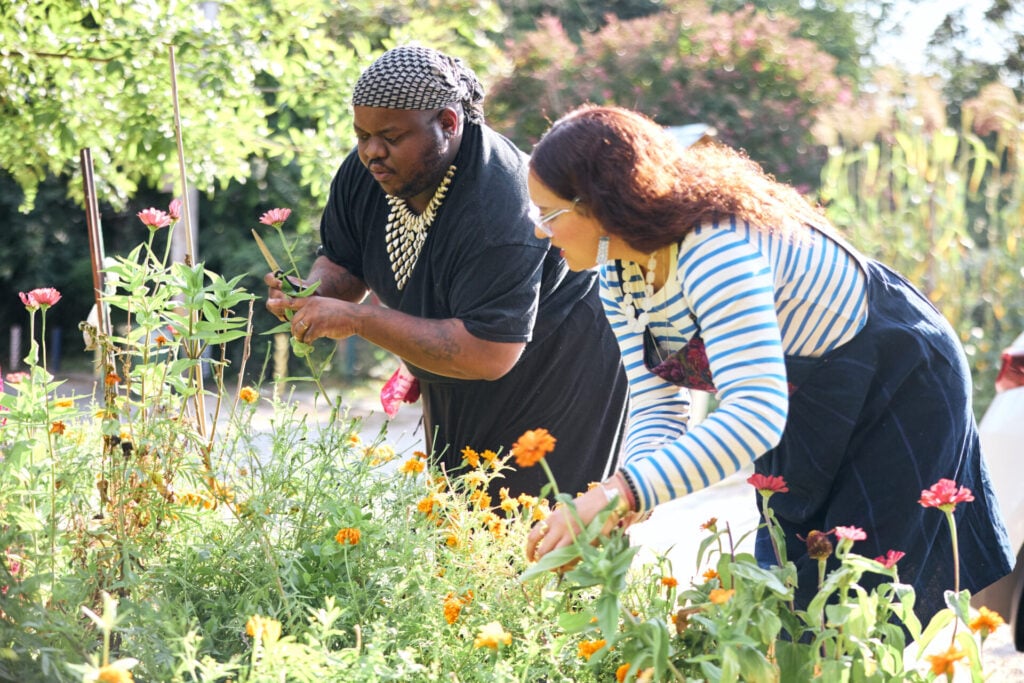
Cara: Kenya, let’s meet back down and let’s go.
Kenya: And I’m not coming back. Bye.
Janette: Yes, you can come. It will be super awesome. Like at the end, we can have something like a showroom or something and you can come or also but the idea is if we, I don’t know, it’s a, it’s an idea. If we work for four months, maybe you can have three months.
Like meeting them online, and at the end, you can meet them in person but this is something that we need to figure out, but the dynamic here in Ni En More will change a little bit because next year we are not going to teach for one year. It will be for support projects that are already, that they will develop, but the mentors will be paid, and will be invited to just accompany the group of fellows….
Kenya: Somebody is going to have to figure it out and I was going to do it. Yeah. Like the and then I’m, like why is this new idea? And it’s you who came up with the idea, like you stopped coming up with ideas, but really wanting to have you here. It was really big, just experiment and play.
We both really felt – especially when the timing worked – “Okay, you were heading to Japan. You had just also come back from somewhere. This is the time I have, and what can be done?” What I really wanted was for people to get to know you and your work.
So I wanted there to be a talk and a small exhibition of your work. I also felt – I am African American in diaspora; you are Mexican, but without lineage specific to the fibers we’re working on. So I really wanted to begin a conversation about that being in diaspora and what it means to connect to these really beautiful cultures and histories. And also to steward them, and then as we have done, you’ve done, and through me and more like Just to be able to help other people, to be a vessel for that for other people.
Whereas we’re trying to figure it out ourselves as well. So for me, I just felt like that experiment and a lot of it is I put a lot on myself just in what it means to be a host and welcoming people. And so I think I really felt like there were certain things that.
It was also just information gathering for me so that as we go forward and we have different events, I want to make sure food is a part of it, that it is culturally relevant. I want to make sure that the atmosphere and the groups that we’re drawing in are people that can really reflect. And then you taught a workshop, which went really well, people had such a great time.
Also, going to New York was one aspect of that, I really felt like you would love and appreciate being at OKO (farms) And just having the capacity to be in a space where we could have bigger conversations with people and be in this in a community of people who are different than the Baltimore community,
That is equally inquisitive about what this is about. I wanted as many people as possible to hear your story and to see every person that did either come to the studio or that went to Oko.
Oh, that book, that book had Oh my gosh, just to be able to see all of the research and the chronological information through dye, through plants, that was just so inspiring for a lot of people. So yeah, it was such a special thing for me for sure.
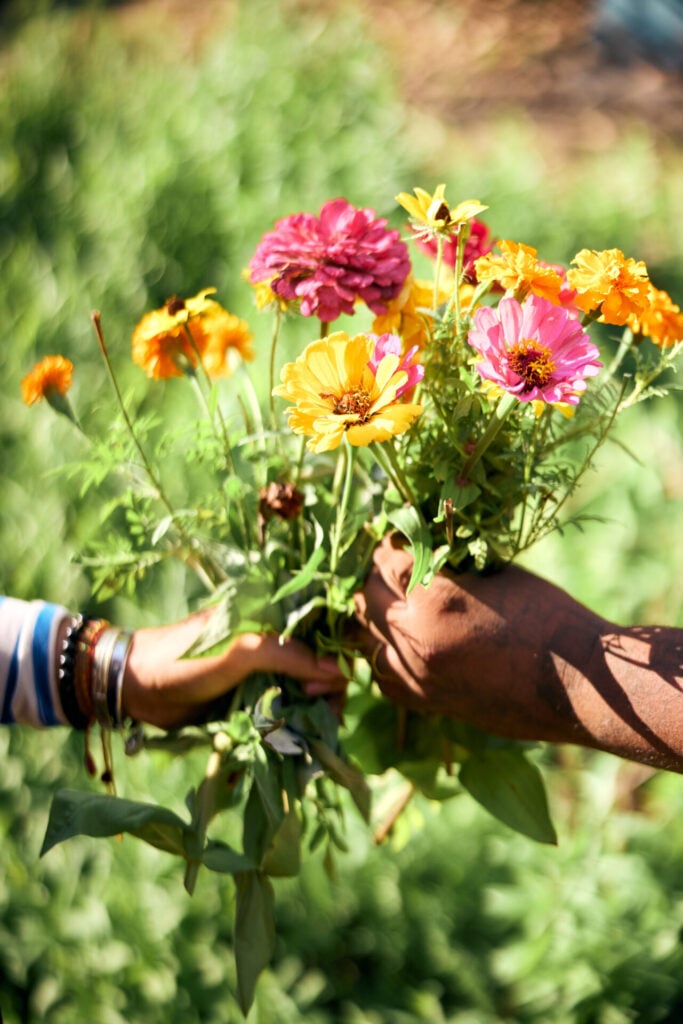
Cara: You both just said a lot of really incredible things, but I really love the synergy between all of the community building that you both are doing and how when you create that kind of field you attract people in that field as well, right?
Whether you’re In the Ciudad Juarez or Baltimore, right? The echo effect has this very special ripple. I’d love to hear more about this book that you made, Janette. I want to know what that was. And then also I love what you were saying, Kenya, about stewarding plants that aren’t necessarily in your ancestral line.
I think that is such an important conversation in the world of natural dyes. I think all of us can relate to that, I know we talked a little bit about this even in the last interview that we did. I’m a Fourth generation southern Italian woman who’s completely stripped from my Mediterranean history, right?
Italian American culture is completely different from Italian culture and I’ll be the first to tell you that. But it’s, it’s funny because it’s like when I work with plants that I know were part of my lineage, like you feel that echo. You feel that magic where you’re specifically drawn to like even just flavors that you know are down the line.
But what it means to also be a New Yorker and do that, right? It’s a conversation around respect. I feel like you both do it with such elegance and dignity, that it feels very I hope that like our readers or listeners, whichever way I might even just put the recording of this so people can hear it.
I think it’d be nice that people bring that into their practice as well because you know, it’s very easy to just grab a bunch of flowers and try the thing but sitting and observing and interacting with them in a way where you think about how far these plants actually go back is really important.
Janette I would love to hear a bit more about your experiments with the corn. Did you work on that while you were in Baltimore? Did you have any specific aha moments? What was your takeaway after you left that you feel like you might be either bringing into your practice or leaving here in America?…
Kenya: I will, I’ll just say one thing. I have many plans to support this corn experiment and research. And I bought the corn that you told me to get or that you were working with. And I grew it, but people. We just didn’t have a system. They didn’t water it and put it out at the right time.
Cara: But that’s nature, right?
Kenya: Yeah, it’s nature, but it’s also people. It’s also people who like, Oh, we’re supposed to put that out? I’m like, what are you talking about? That’s funny.
Janette: In 2021, I documented botanical colors from Mexico as part of my thesis. I traveled to many places, including Paquimé, an archaeological area with clay work, and the coasts with Red Mangle. I created a patchwork series in contemporary art with the colors I found. The corn project was more personal, related to my family’s history of migration, cotton-picking, and corn-growing. We set up a small exhibition about this documentation, sharing the story of my grandparents and the Mexican revolution, which resonated with many people.
Kenya: When I moved to Baltimore, I became involved in urban farming, which was new to me. Over six years, I’ve become a co-steward of a farm near my home. The Baltimore Farm Alliance has been crucial in our growth, and we’ve cultivated on their teaching farm for the past two years. During the pandemic, focusing on our local area felt manageable and impactful. The community was excited to meet Janette and learn from her experiences.
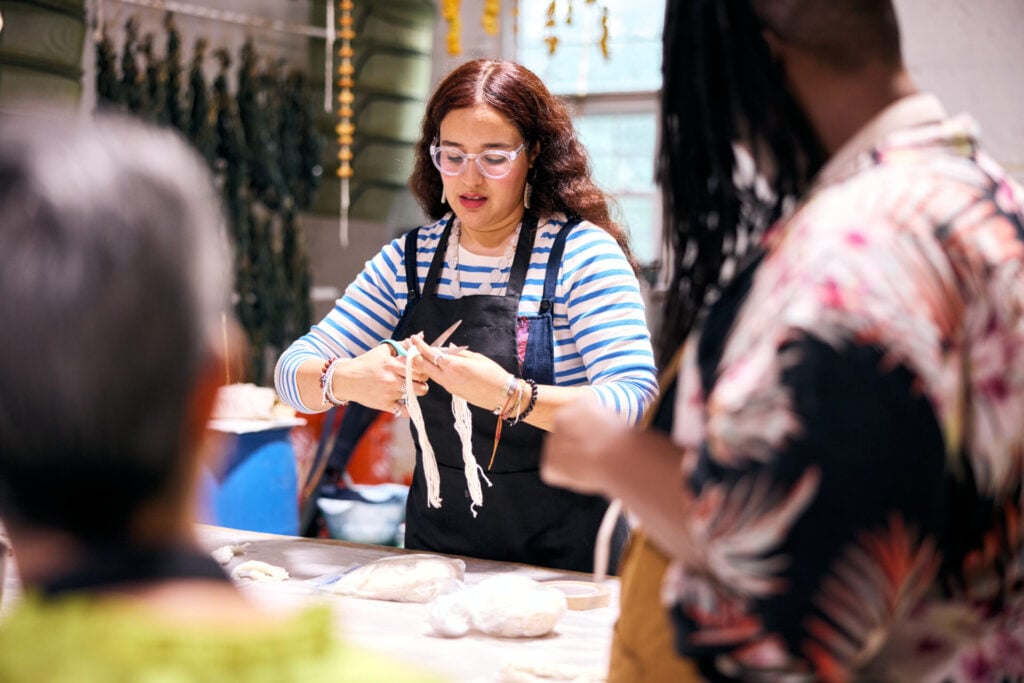
Cara: How did Janette’s visit enrich the community?
Kenya: It was incredibly valuable. My goal is to have a place to house visitors, allowing them independence while feeling safe. Janette’s visit demonstrated the benefits of offering various engagement opportunities – an exhibition, talk, trunk sale, and workshop – allowing people to participate at different levels.
Cara: What are your plans for 2025, and what advice would you give to someone wanting to start organizing in their local community?
Janette: You can start in your neighborhood or city. In 2017, we began with embroidery workshops, creating a space for women to express themselves and heal while crafting. Currently, I’m focused on water protection, using cochineal to test river water pH levels. We’re also expanding our support for young entrepreneurs and designers, promoting ethical fashion production.
Kenya: Blue Light started in January 2020, just before the pandemic. Our garden became a place of respite for many, especially during protests. We also set up a community fridge for donations. My advice is to be prepared for opportunities, align with your values, and have open conversations about your goals. Immerse yourself in the areas you’re interested in, but don’t get ahead of yourself. Allow for emergence while gradually introducing structure.
The key is to focus on one-to-one connections, intimacy, and the details of togetherness. Start small and let your project grow organically .I love that quote, “ small is all” like it really is about one to one connections, being in the intimacies and the details of togetherness and love and fellowship and food. And I just am always pleased when I see people pleased at the studio, I’m like, Oh, you really like this shit, huh? That’s crazy. I think it’s great. But it’s nice to see that people can become believers once they experience what has been nurtured. And so, that’s what I wish for other people is to nurture things that mean something to them.
Cara: Ah, what a beautiful way to close it out.
